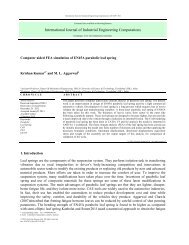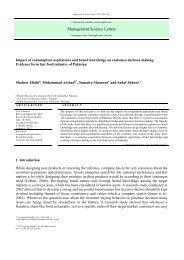Download PDF - Growing Science
Download PDF - Growing Science
Download PDF - Growing Science
You also want an ePaper? Increase the reach of your titles
YUMPU automatically turns print PDFs into web optimized ePapers that Google loves.
1514<br />
the decision levels, whereas ANP is used to evaluate a dynamic multi-directional relationship among<br />
the decision attributes (Mohantry et al. 2005). Although ANP can capture the interdependencies<br />
between the criteria under consideration, it has its own disadvantages. One of the limitations in ANP<br />
is that it needs more comparisons than the AHP, which makes it time consuming and frustrating.<br />
However, complex decisions may need such complex technique. Another limitation might exist in<br />
case there are different alternatives in decision model. In terms of making a number of pair-wise<br />
comparisons, it would be interesting (Bayazi, 2006). ANP requires more calculations and formation<br />
of additional pair-wise comparison matrices compared with the AHP process. (Ravi et al. 2005).<br />
2.2. Considered criteria<br />
Inappropriate criteria choice is the prime cause of inadequate contractor selection. Correct<br />
importance of criteria and selection of suitable techniques are equally important (Banaitienê &<br />
Banaitis, 2006). The efficiency of a construction process is normally associated with the successful<br />
choice of a contractor (Hatush & Skitmore, 1998). During the past few years, the predominant<br />
procurement process in construction has been the competitive ‘‘low-bid” procurement process, which<br />
has encouraged an increase in the pressure on price, proliferation of construction systems and<br />
products to meet the minimum requirements, more pushes for contractors to generate greater volume,<br />
and construction non-performance and litigation. The low-bid process has not produced the results<br />
facility owners, require. It has produced low-quality work, adversarial working circumstances, a high<br />
incidence of contractor-generated change orders, claims, litigation and increased project management<br />
costs, and this has nothing to do with quality. No one is interested in the system, but everyone<br />
understands it (Kashiwhgi & Byfield, 2002).<br />
The construction industry is dynamic in nature and the concept of project success has remained<br />
ambiguously defined. The success of construction project is almost the ultimate objective for every<br />
project but the definition is completely vague (Chan & Chan, 2004). In practice, there are different<br />
procedures for contractor selection and all of them are aimed at choosing a qualified contractor on a<br />
competitive basis, but in reality a decision is usually based on a single criterion (Hatush & Skitmore,<br />
1998). Therefore, price criterion is a decisive in contractor selection. Lately the ‘‘lowest bid”<br />
selection practice has been argued since it involves high-risk exposure of the client. The selection<br />
based on the low price basis is one of the reasons for project completion delays, poor quality and/or<br />
financial losses, etc. An offered bid price is an important item in choosing a contractor, but there are<br />
many other important issues, which are important in project implementation, which have to be in the<br />
contractor’s evaluation process (Hatush & Skitmore, 1998; Zavadaskas & Vilutiene, 2006).<br />
The increase emphasis directed towards encouraging lowest bid price requires to be redirected<br />
towards establishing contractor’s ability to reach project owner’s satisfaction by providing high<br />
project performance (time) and high quality of completed product (Holt et al. 1995). The outcome of<br />
a construction project is measured in terms of cost, time, and quality achieved. Therefore, these are<br />
three main concepts for contractor selection procedure (Holt, 1998). Based on these main concepts, a<br />
list of criteria can be prepared and these criteria are utilized at contractor’s prequalification, which is<br />
another frequently implemented procedure of choosing contractors (Ng & Skitmore, 1999). As stated,<br />
qualified contractors from a group of interested applicants are chosen in terms of their<br />
prequalification criteria (Ng & Skitmore, 1999; Palaneeswaran & Kumaraswamy, 2001).<br />
There are other contractor selection methods based on the assumption that information on tenders<br />
exists during the decision making process of the client. However, this assumption is only applicable<br />
where there are experienced developers of large-scale works or with the advice of building<br />
consultants who provide the necessary data on the present status and the past performance of each<br />
contractor at a relatively low cost of required data. They may even have their own data obtained from<br />
the previous contractors. It becomes necessary to build prequalification lists of contractors and<br />
quantitative measures of contractors’ performance (Luu et al., 2003). Latham defended a








